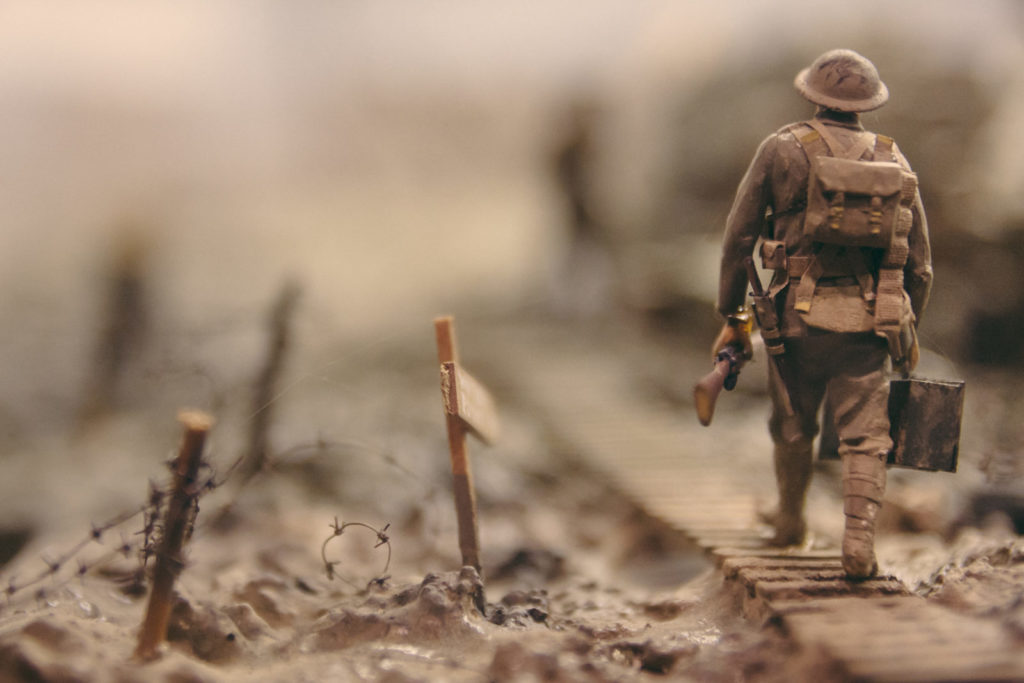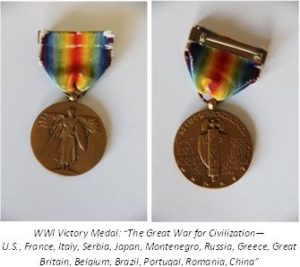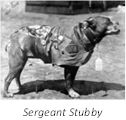Your Tour of Duty: Find Your Kindred Dead from World War I
 8
8Nov
Many of us remember the older generation in our family that served in World War I. With this Sunday being the 100th anniversary of the end of hostilities of one of the most horrific bloodbaths in world history, it is fitting that we should honor their service and learn a little more about them. The armistice, which became Veterans Day in the United States, was signed on the 11th hour of the 11th day of the 11th month, 1918, in a railway car in Compiègne, France. Many words and cultural symbols have entered our vocabulary from “the war to end all wars,” such as: Great War, doughboy, Flanders Field, Meuse-Argonne, Somme, Château-Thierry, Belleau Wood, pillbox, tank, sniper, over the top, shrapnel, poppies, and much more.

Often in genealogy, we focus on the end-of-the-line generation, always trying to push back further in time. That is great, but there is so much between the present and the distant past that is worthy of our attention and documentation. The stories are memorable and will always attract a new generation of readers. So many families were affected by World War 1—4.7 million Americans served, 116,700 died, and 204,000 were wounded.[1] It is a stark statistic when one realizes that the number of deaths sustained by United States forces represents 2% of the total number of deaths among the Allied or Entente powers, not to mention the deaths among the Central powers.


Commemorative events are scheduled across America and Europe. In Pershing Square this weekend, near the White House, there will be “A First Look” event at the upcoming National World War I Memorial. Across this land, there will be Veterans Day runs, parades, and centennial commemorations. You can participate in the Bells of Peace right at 11 a.m. local time on November 11th. If you are in Kansas City, the National World War I Museum and Memorial would be a great place to visit. For an animated family movie, consider watching Sgt. Stubby: An American Hero, which was released in April of this year. This Bull Terrier was the mascot of the 102nd Infantry Regiment and served in seventeen battles.[2]
As you embark on your tour of duty or reconnaissance in pursuit of your World War I soldier, these online resources and listings will deploy you to your field of combat (to recover the memory of your kindred dead):
- World War I United States Military Records, 1917 to 1918: This is an extensive compilation of websites covering a wide range of relevant topics. The timeline of the American Expeditionary Forces is particularly useful.
- Brigham Young University hosts an outstanding webpage called Links to Other WWI Sites with links to information on the involvement of men and women from many countries in the war. It includes genealogical resources, literature, maps and atlases, music, visual arts, films, photographic collections, and much more.
- For your British forces ancestor, The Great War 1914-1918 is a good place to begin.
- It is a sad reflection to learn that 80% of the U.S. Army records from 1912 to 1960 were destroyed in the July 1973 fire at the National Personnel Records Center (NPRC) in St. Louis, Missouri.[3] This is where surviving Official Military Personnel Files (OMPF) can be obtained by submitting an application. You can download the SF-180 request form here. Unfortunately, 16 to 18 million OMPFs were lost in the fire. The NPRC holds 100 million OMPFs of veterans, but these go well beyond WWI. Some destroyed files were reconstructed in order to provide services to veterans. Many veterans retained their own copies of discharge papers, and some of these still survive among their descendants. The National Archives has a good introductory page for genealogists. Looking beyond personnel service records, general histories and unit histories can be found at many research agencies, institutes, archives, and records centers scattered around the country, with several major Record Groups found in Washington, D.C.
| World War I draft registration cards |
- Ancestry’s collection, S., World War I Draft Registration Cards, 1917-1918 contains 24 million images of draft cards of American men born from 1872 to 1900 and represents 25% of the American population. It is a fantastic genealogical resource of men who were eligible for the draft, but it does not mean they were actually called up. These records contain names, residences, birthplaces and birthdates, occupations, employers, citizenship status, the nearest relatives, and more. There were three registrations, each pertained to men of different age groups. The number of questions varied as well from one group to another. This collection can also be found on FamilySearch for free.
- It is not just national sources that should be considered. State World War I records contain a treasure trove of information. See also, United States World War I State and Local Histories. These are not all held in one place. They can be found at state archives, offices of state adjutants general, genealogical and historical societies, and university research libraries. Many returning soldiers deposited their discharge papers at their county courthouse for a permanent record of their honorable service. Local publications may include brief biographies of your ancestors.
- The Department of Veterans Affairs (VA) records are not held in St. Louis. Their website contains the Nationwide Gravesite Locator of the National Cemetery Administration. This includes national and state veterans’ cemeteries, and even private cemeteries, if an official government grave marker was issued. If your ancestor was buried overseas, you will want to consult the American Battle Monuments Commission (ABMC) website, where you can search by name. The ABMC maintains American cemeteries outside the United States. Soldiers who fought for Great Britain, and who died overseas, are listed with the Commonwealth War Graves Commission.
- Fold 3: This outstanding website focuses largely on American military records. For World War I, it contains 121 million records across 71 collections. Many are British records, such as War Diaries. The WWI Canadian Soldiers database contains document images for each soldier and there is a good prospect of finding your Canadian ancestors in it. On Ancestry, which owns Fold 3, see the “Canada, WWI CEF Attestation Papers, 1914-1918.” Within the World War I collection on Fold 3, a search by name is likely to bring results on your ancestors. Always check for siblings and other relatives, as collateral research often breaks through brick walls.
- Family Ties: This is a place where you can preserve stories of the military service of your family members who served in World War I. See The United States World War One Centennial Commission website for an explanation. You can even “Donate an Artifact” if you have one.
- There are lots of ways to educate yourself or a group of people on the war, including the lesson plans at the World War I Centennial Commemoration Curriculum
- Many World War I soldiers in May 1918 were given an expedited path to citizenship. The residency requirements and Declarations of Intention were waived. Soldiers were able to file petitions and complete their naturalization both on the same day. Copies should be on file in the local court where the event occurred and in the records of the Immigration and Naturalization Service (INS). On FamilySearch, see the collection “United States Index to Naturalizations of World War I Soldiers, 1918.” This index also came from Fold 3.
| Men of the 127th Spruce Squadron, including the grandfather of this writer, and his dog tags. |
Different wars and time periods generate different records. Military personnel records often include information on conscription (draft), enlistments, training, postings, transportation (embarkation), casualty reports, disciplinary actions, promotions, awards and medals, muster rolls, service, discharge, unit histories, bonus applications, hospitalization, disability, POW status, soldiers’ homes, and burials. While pension records were common in earlier American wars, by the 20th century they were not offered. Some states, and the federal government in the 1930s, offered bonuses for service.
When you see words like attrition, camouflage, flamethrower, gas mask, machine-gun, mustard gas, tank, trench warfare, u-boat, ace, Tommy, over there, liberty cabbage (sauerkraut), or unknown soldier, let’s remember the brave and often scared soldiers of the past.[4] But, even more importantly, let’s remember the service men and women of the present generation, and especially those who sustained disabilities during their military service, for their heroism in defending liberty. Just as stories of previous generations of veterans need to be recorded for posterity, so do the living memories of those who our country has asked to place their lives in modern-day crucibles of war. What may seem common today, will be commemorated as extraordinary to our children and to their children. Not that long ago, World War I veterans could be found everywhere, but now they honor the pages of history books and of our family histories. May we do our part to ensure that they are not forgotten and that we cherish the liberties they left us.
Greg
5 November 2018
If you have been thinking of someone in your family who served in World War I, now may be a good time to prepare a written account of their service and their life. This was an epic conflict, and tragic in so many ways. The expert researchers at Price Genealogy can assist you in discovering your family’s part of the story.
| Honorable Discharge papers & Enlistment record of the grandfather of this writer— He served as a private in the 127th Squadron of the A.S.A.P. |
[1] “World War I casualties,” Wikipedia (accessed 5 November 2018).
[2] “Sergeant Stubby,” Wikipedia (accessed November 2018).
[3] “The 1973 Fire, National Personnel Records Center,” National Archives (https://www.archives.gov/personnel-records-center/fire-1973 : accessed 5 November 2018).
[4] “100 Words that Define World War I,” OED: Oxford English Dictionary (https://public.oed.com/blog/june-2014-update-100-words-that-define-world-war-i/# : accessed 5 November 2018).
